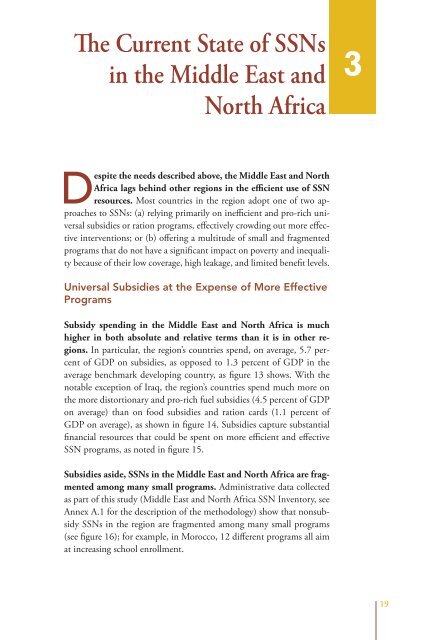You also want an ePaper? Increase the reach of your titles
YUMPU automatically turns print PDFs into web optimized ePapers that Google loves.
The Current State of SSNs<br />
in the Middle East <strong>and</strong><br />
North Africa<br />
Despite the needs described above, the Middle East <strong>and</strong> North<br />
Africa lags behind other regions in the efficient use of SSN<br />
resources. Most countries in the region adopt one of two approaches<br />
to SSNs: (a) relying primarily on inefficient <strong>and</strong> pro-rich universal<br />
subsidies or ration programs, effectively crowding out more effective<br />
interventions; or (b) offering a multitude of small <strong>and</strong> fragmented<br />
programs that do not have a significant impact on poverty <strong>and</strong> inequality<br />
because of their low coverage, high leakage, <strong>and</strong> limited benefit levels.<br />
Universal Subsidies at the Expense of More Effective<br />
Programs<br />
Subsidy spending in the Middle East <strong>and</strong> North Africa is much<br />
higher in both absolute <strong>and</strong> relative terms than it is in other regions.<br />
In particular, the region’s countries spend, on average, 5.7 percent<br />
of GDP on subsidies, as opposed to 1.3 percent of GDP in the<br />
average benchmark developing country, as figure 13 shows. With the<br />
notable exception of Iraq, the region’s countries spend much more on<br />
the more distortionary <strong>and</strong> pro-rich fuel subsidies (4.5 percent of GDP<br />
on average) than on food subsidies <strong>and</strong> ration cards (1.1 percent of<br />
GDP on average), as shown in figure 14. Subsidies capture substantial<br />
financial resources that could be spent on more efficient <strong>and</strong> effective<br />
SSN programs, as noted in figure 15.<br />
Subsidies aside, SSNs in the Middle East <strong>and</strong> North Africa are fragmented<br />
among many small programs. Administrative data collected<br />
as part of this study (Middle East <strong>and</strong> North Africa SSN Inventory, see<br />
Annex A.1 for the description of the methodology) show that nonsubsidy<br />
SSNs in the region are fragmented among many small programs<br />
(see figure 16); for example, in Morocco, 12 different programs all aim<br />
at increasing school enrollment.<br />
3<br />
19



